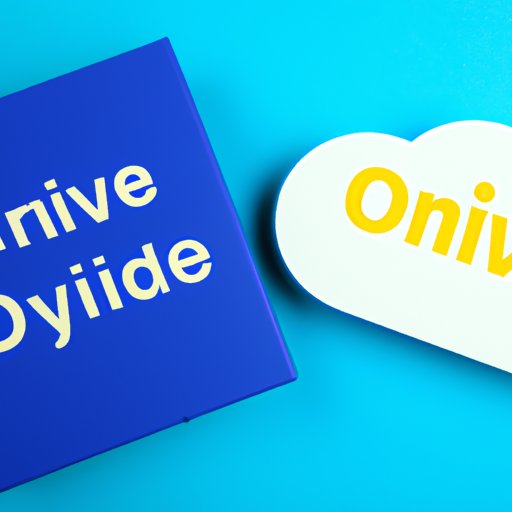How to Turn off OneDrive: A Step-by-Step Guide
OneDrive is a cloud-based file hosting service created by Microsoft, available for free to anyone with a Microsoft account. By default, OneDrive is integrated into all Microsoft Windows installations, and it can be incredibly convenient for syncing files across devices. However, there can be a variety of reasons why someone may want to completely turn off OneDrive, such as data privacy concerns, limited storage space, or large file sizes. In this article, we’ll provide a complete guide on how to turn off OneDrive and offer alternatives to consider.
Step-by-Step Guide: How to Turn Off OneDrive Completely
Here’s how to disable OneDrive completely on Windows, the OneDrive website, and mobile devices:
Disable OneDrive on a Windows PC
1. Right-click on the OneDrive icon in the taskbar and select ‘Settings’.
2. Under the ‘Settings’ tab, click on the ‘Unlink OneDrive’ button.
3. Follow the prompts to remove OneDrive from your system.
Disable OneDrive on the OneDrive website
1. Go to OneDrive.com and sign in.
2. Click on your name in the top right corner and go to ‘Account Settings’.
3. Select ‘Device backups’ and turn off the switch for ‘Desktop Backup’.
4. Go back to ‘Account Settings’, navigate to the ‘Personal’ tab, and click on ‘Delete your OneDrive account’ to proceed.
Turn off OneDrive on a Mobile Device
1. Open the OneDrive app on your mobile device.
2. Tap on the three horizontal lines in the top left corner and then select ‘Settings’ from the dropdown menu.
3. Turn off the switch for ‘Camera Upload’ to stop OneDrive from automatically syncing your photos.
Alternatives to OneDrive: What to Use Instead
If you’re looking for an alternative to OneDrive, here are some of the popular options:
- Google Drive: A cloud-based service from Google that offers similar features to OneDrive.
- Dropbox: A file hosting service that focuses on file sharing and collaboration, providing cross-platform support.
- iCloud: Apple’s cloud service, available for those who use Apple devices.
If you decide to switch to another cloud storage service, you can use the backup and restore functions provided by most services to migrate your files.
Reasons to Turn off OneDrive: When and Why to Disable It
While OneDrive can be extremely handy, there are situations where you may want to turn it off completely:
- Data Privacy Concerns: Some users may not want to store sensitive information in a cloud-based service.
- Large file sizes: OneDrive has limitations to the size of files you can store, and this may prove problematic for larger files or videos.
- Storage Space: OneDrive limits the amount of free storage that you have. Initially, you are provided 5GB free storage, which may not be enough for some users.
Troubleshooting OneDrive: Why it Won’t Turn Off and What to Do
If you are experiencing trouble turning off OneDrive, here are some common issues and how to address them:
- OneDrive is actively syncing files. Before disabling OneDrive, ensure that any syncing is complete beforehand.
- OneDrive installation issues: Attempt to completely uninstall OneDrive from your system and then re-install it, and follow the steps provided above.
Disabling OneDrive on a Specific Device: Your Ultimate Guide
Here’s how to turn off OneDrive on Windows PCs, Macs, Android, and iOS mobile devices:
Windows:
Go to the OneDrive settings and unlink it from your device.
Macs:
In the upper menu bar, click on OneDrive and then select ‘Preferences’. Go to the Account tab and click on ‘Unlink’. Follow the prompts to remove OneDrive from your system.
Android:
Open the OneDrive app, and go to ‘Settings’ > ‘Camera Upload’ > ‘Turn off’. To stop other files syncing, go to ‘Settings’ > ‘Account’ > ‘Unlink this device’.
iOS:
From the home screen, tap on ‘Settings’ > ‘OneDrive’. Turn off ‘Camera Upload’ or sign out of your account to fully exit OneDrive.
How to Permanently Disable OneDrive: A Comprehensive Guide
If you want to prevent OneDrive from running in the background of your device, you can follow these steps to disable it:
1. Press ‘Windows key + R’ to open the ‘Run’ dialog box.
2. Type ‘gpedit.msc’ and press Enter to open the Group Policy Editor.
3. Navigate to ‘User Configuration’ > ‘Administrative Templates’ > ‘Windows Components’ > ‘OneDrive’.
4. Double-click on ‘Prevent the usage of OneDrive for file storage’ and select ‘Enabled’.
5. Click on ‘OK’ and then restart your computer.
If you’d like to remove OneDrive from your Windows OS completely, follow these steps:
1. Type ‘Control Panel’ in the search box, open it, and select ‘Programs and Features’.
2. Locate ‘Microsoft OneDrive,’ click on it, and then select ‘Uninstall’.
3. After the uninstallation is complete, you can verify that OneDrive has been successfully removed from your computer.
Conclusion
Whether you’re looking to free up space, switch to another cloud service, or are concerned about data privacy issues, disabling OneDrive completely can be an important step in safeguarding your information. By following the step-by-step guide outlined in this article, you can turn off OneDrive on all your devices with ease.
Remember, if you encounter any issues, we’ve also provided tips on how to troubleshoot common problems. Whatever the reason may be, you now have the knowledge and resources necessary to permanently disable OneDrive.
